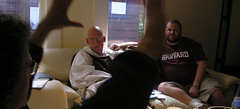The Future of Social Science in the Era of the Internet
Social science today has an opportunity to create an online infrastructure for social valuation that becomes participatory to a degree far exceeding the contemporary rule. While nineteenth-century social scientists worked for government elites, an online infrastructure designed to illuminate world view would place the tools of cultural observation within reach of many minds. Opening up representation of landscape has the opportunity to directly channel participation into urban planning, tax policy, housing policy, social services, and other aspects of the representation and administration of the physical landscape. It is hoped that application, articles, and videos will pioneer a new role for social science in the era of social networking technology, and foreground the cause of democratizing social science’s power.
So long as government interests dominated the social sciences, the work of the social scientist aimed at influencing the work of the national government. Historian, sociologist and geographer worked to describe cases of state success and failure, expectant that the state would build according to their plans. The end of that political relationship opens up a radical opportunity. Social scientists in the age of the internet have the opportunity to work directly on behalf of communities without the interface of government.
In the age of the internet, radical participatory information exchanges, market and political exchanges replace much of the work of the state. In such a setting, many of the social science’s traditional roles become irrelevant. Social scientists no longer advise a state in charge of designing public spaces where members of identity groups can safely meet. Informal, market-driven social servers such as LinkedIn.com, Facebook.com, and Myspace.com become significant forums for social exchange. Social scientists such as danah boyd have documented the divides of race and class in these sites. But who do they advise? There are no urban planners overseeing Facebook.
Few social scientists have explored the radical opportunities available at the level of design. Launched from independent geeks, corporate start-ups, and computer science departments, new applications spring up constantly, tweaking the infrastructure of social exchange. One application allows Flickr.com photos to appear on Facebook’s wall. Another shows the user a rotating cloud of all the pictures semantically related to a given search term. Fundamentally, these applications are about making connections; their success actually depends upon broadening the internet’s infrastructure to become as participatory as possible.
One of the greatest challenges to participatory exchange on the internet is the limit of transcultural boundaries. Users’ gender, class, race, and identity are obscured online, surfacing as an invisible law of self-association. Reduplicating the isolation of society at large, affluent whites on the internet share information with affluent whites, while the children of immigrants or immigrants themselves populate.
Here the history of the academic disciplines provides insight. Social scientists employed by the state once combated ethnic segregation in the city by prescribing programs such as public housing designed to enhance identity assimilation. Their work tended to generalize racial differences into differences of violence, gender organization, and attitudes towards work.
Armed with new forms social expertise – planners, architects, and geographers – charged with managing the boundaries between cultural worlds, based upon the assumption that the only way world views could be reconciled at large was through the management of the state. Nowhere was this trend clearer than among the experts who embarked upon a discipline new to the twentieth century, the study of cities. Urban scholarship flourished around what was becoming known as the “urban crisis,” the post-civil-rights-era phenomenon of black inner-cities ringed by ethnically divided white suburbs. Intellects as diverse as economist Edward Glaeser, geographer David Harvey and historian Arthur Schlesinger Jr. examined the historical health of urban administration with an eye to the future of racial integration in America. Geographers asked whether overcrowding in public housing contributed to interracial violence. Child psychologists asked whether access to green spaces influenced the development of creative powers. Social scientists intended to describe the ideal city, and they expected the state to build it.
Their efforts, frequently belittling or primitivizing minority ethnicities, urged their students to concentrate upon designing a single, ideal, national landscape: a design for cities, frequently modernist, that would help immigrants of many backgrounds to assimilate to the same culture. By ignoring difference, they hoped to efface it. Their trajectory was marked by failure, and by the year 2000, Chicago and St. Louis were tearing down the housing projects erected under that regime.
Faith in expert management of cultural infrastructure by sociologists and psychologists gave rise to an unprecedented level of authority being given modern urban planning. The public housing projects erected under their charge took American and British neighborhoods out of the hands of the local ethnic minorities who had built them. Far from the master travelers envisioned by early students of world view, twentieth-century planning aimed to assimilate ethnic minorities by effacing cultural difference.
By contrast, in advising and enabling the oversight of design for online infrastructure, academics in the social sciences can facilitate collaborative knowledge making by communities about themselves.
Labels: activism, chicago school of sociology, class, design, gender, geography, graduate school, history, internet, race, social science, urban planning










0 Comments:
Post a Comment
<< Home